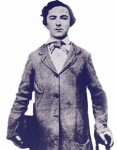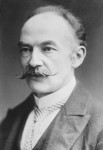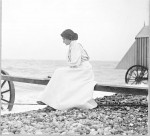 Saturday, August 9th, 1856, Elizabeth Martha Brown was hanged in front of Dorchester Gaol. A month earlier she had killed her husband John with multiple hatchet blows to the head. The marriage, needless to say, had not been a happy one. She was a housekeeper, he a servant at Blackmanston Farm. She was said to be a handsome woman with a beautiful head of thick, curly hair, but she was 20 years older than her husband and it was generally thought that he married her for money. Her £50 savings allowed the couple to move to Birdsmoorgate in the Marshwood Vale and open a shop. Soon she suspected him of having an affair with a younger woman, Mary Davis, who ran a shop near theirs, and according to Martha, he became verbally and physically abusive towards her. One night he got home in the wee hours and by morning he was dead.
Saturday, August 9th, 1856, Elizabeth Martha Brown was hanged in front of Dorchester Gaol. A month earlier she had killed her husband John with multiple hatchet blows to the head. The marriage, needless to say, had not been a happy one. She was a housekeeper, he a servant at Blackmanston Farm. She was said to be a handsome woman with a beautiful head of thick, curly hair, but she was 20 years older than her husband and it was generally thought that he married her for money. Her £50 savings allowed the couple to move to Birdsmoorgate in the Marshwood Vale and open a shop. Soon she suspected him of having an affair with a younger woman, Mary Davis, who ran a shop near theirs, and according to Martha, he became verbally and physically abusive towards her. One night he got home in the wee hours and by morning he was dead.
At first she denied having murdered him. She claimed he’d been kicked in the head by a horse 200 yards away from the house and somehow made his way home where he expired. A doctor found that there was no way he could have walked home with the injuries he’d suffered. Martha stuck to her story but the jury at the Dorchester Crown Court were not persuaded and she was condemned to hang. It was widely believed that her insistence on sticking to her patently false cover story sealed her doom, that if she had confessed and repented, her life would have been spared. On top of the horse kick lie, her calm demeanor at the trial was interpreted as callousness.
Just before she was executed, Martha Brown signed a full confession.
“My husband, John Anthony Brown, deceased, came home on Sunday morning, the 6th of July, at two o’clock, in liquour, and was sick. He had no hat on. I asked him what he had done with his hat. He abused me, and said, ‘What is it to you, d–n you.’ He then asked for some cold tea. I said that I had none, but would make some warm. He replied, ‘Drink that yourself, and be d—d.’ I then said, ‘What makes you so cross? Have you been at Mary Davis’s?’ He then kicked out the bottom of the chair upon which I had been sitting.
We continued quarrelling until about three o’clock, when he struck me a severe blow on the side of my head, which confused me so much that I was obliged to sit down. Supper was on the table, and he said, ‘Eat it yourself, and be d—d.’ At the same time he reached down from the mantelpiece a heavy horse-whip, with a plain end, and struck me across the shoulders with it three times. Each time I screamed out.
I said, ‘If you strike me again I will cry, Murder.’ He retorted, ‘If you do, I will kick your brains out through the window.’ He also added, ‘I hope I shall find you dead in the morning.’ He then kicked me on the left side, which caused me much pain, and he immediately stooped down to untie his boots.
I was much enraged, and in an ungovernable passion, on being so abused and struck, I directly seized a hatchet which was lying close to where I sat, and which I had been using to break coal with to keep up the fire and keep his summer warm, and with it (the hatchet) I struck him several violent blows on the head. I could not say how many.
He fell at the first blow on his head, with his face towards the fireplace. He never spoke or moved afterwards. As soon as I had done it, I wished I had not, and would have given the world not to have done it. I had never struck him before, after all his ill treatment, but, when he hit me so hard at this time, I was almost out of my senses and hardly knew what I was doing.
By all accounts, Martha was composed and calm as she climbed the scaffold. Her attendants and the chaplain were more upset than she. The hangman tied a rope around her dress at the ankles to prevent her gown from flying up and exposing her during the drop. A white hood was placed over her head. The Reading Mercury of August 16th, 1856, reported that “the wretched woman fell with great force, and after a few struggles ceased to exist.”
 Martha Brown was the last woman to be publicly hanged in Dorset. Dorchester, which had a centuries-long history of exceptionally brutal public executions, hadn’t had a hanging in 26 years and people flocked to see this woman breathe her last. Close to 4,000 people filled North Square for the revival of what had once been called “hang fairs.” One of the spectators was a 16-year-old apprentice architect named Thomas Hardy. The hanging of Martha Brown made an indelible impression on the young man, so much so that 35 years later he would write a novel about a tragic heroine who staves in the head of the abuser who ruined her life and is hanged for it.
Martha Brown was the last woman to be publicly hanged in Dorset. Dorchester, which had a centuries-long history of exceptionally brutal public executions, hadn’t had a hanging in 26 years and people flocked to see this woman breathe her last. Close to 4,000 people filled North Square for the revival of what had once been called “hang fairs.” One of the spectators was a 16-year-old apprentice architect named Thomas Hardy. The hanging of Martha Brown made an indelible impression on the young man, so much so that 35 years later he would write a novel about a tragic heroine who staves in the head of the abuser who ruined her life and is hanged for it.
 Writing Tess of the d’Urbervilles couldn’t exorcise the memory of Martha Brown. Seventy years later in 1925 Thomas Hardy found himself in Martha’s old stomping grounds when he visited the estate of Racedown in the Marshwood Vale where Wordsworth and Coleridge had once stayed. He asked Racedown’s owner, Lady Hester Pinney, to find out more about Martha Brown. In correspondence with Lady Hester he explained his personal connection to the case.
Writing Tess of the d’Urbervilles couldn’t exorcise the memory of Martha Brown. Seventy years later in 1925 Thomas Hardy found himself in Martha’s old stomping grounds when he visited the estate of Racedown in the Marshwood Vale where Wordsworth and Coleridge had once stayed. He asked Racedown’s owner, Lady Hester Pinney, to find out more about Martha Brown. In correspondence with Lady Hester he explained his personal connection to the case.
“I am ashamed to say I saw her hanged, my only excuse being that I was but a youth and had to be in the town at that time for other reasons… I remember what a fine figure she showed against the sky as she hung in the misty rain, and how the tight black silk gown set off her shape as she wheeled half-round and back.
The hanging itself did not move me at all. But I sat on after the others went away, not thinking, but look at the figure… turning slowly round on the rope. And then it began to rain, and then I saw they had put a cloth over the face how as the cloth got wet, her features came through it. That was extraordinary. A boy had climbed up into a tree nearby, and when she dropped he came down in a faint like an apple dropping from a tree. It was curious the two dropping together.”
 Hardy’s second wife Florence also wrote to Lady Pinney: “Of course the account TH gives of the hanging is vivid and terrible. What a pity that a boy of sixteen should have been permitted to see such a sight. It may have given a tinge of bitterness and gloom to his life’s work.”
Hardy’s second wife Florence also wrote to Lady Pinney: “Of course the account TH gives of the hanging is vivid and terrible. What a pity that a boy of sixteen should have been permitted to see such a sight. It may have given a tinge of bitterness and gloom to his life’s work.”
A little more than a tinge, I’d say. The next year Lady Pinney visited Hardy and they talked about Tess and Martha “whose stories have much in common, just as if they were in the next room. His sympathy for these unhappy women was wonderful.”
The Dorchester prison was closed in 2013 and developers plan to build homes on the site. An archaeological survey found human remains, not in the prison burial ground but outside consecrated ground. This was not unexpected. The dead of Dorchester Gaol were buried in a cemetery on the grounds and outside of it. The remains were left in situ and any that will be disturbed by future construction will be removed and reburied.
The thing is, one of those buried individuals may be Martha Brown, and there are a lot of Thomas Hardy fans who want this possibility explored.
Nick Gilbey, a Dorset-based film-maker and Hardy fan, said: “I don’t think it would be too difficult to establish if any of the remains are those of a woman. If they are, they are almost certain to be the remains of Martha.”
He said a full examination of the prison site should take place. “I think more work needs to be done, and we need to make sure that whatever remains are found there are given a proper, decent burial. Martha is an important historical figure because of the Hardy connection.”
Reminds of the sentence ‘regarding the painful investigation against Susanna Margarethen Brandtin‘, who in Frankfurt got her head separated from her body on January 14th 1772, remarkably ‘in a single stroke‘ for allegedly killing her newborn child.
The case apparently made an ‘indelible impression‘ on the young Goethe, who re-used her character literarily in his ‘Faust‘. The boy itself, i.e. the child not Goethe, was said to have been premature and to have died during birth.
Goethe witnessed the execution and had surprisingly close contacts to all kinds of parties involved in the case.
Oh wow, beheading for murder. That’s not something they did in Britain. Beheading was a merciful gift reserved for purportedly adulterous queens and one king.
I hadn’t heard the Goethe story. Fascinating. I wonder how many other authors had similar formative experiences in the era of public executions.
This is one of the most interesting blogs you’ve ever posted. I’ve enjoyed every syllable. Thank you!
Gosh, thank you. :thanks:
If it was murder. Also, ‘painful investigation’ at least alludes to torture.
While the Brandt case may have been an accident instead of murder, and it seems that many saw it that way, Gretchen ‘drowning’ her child, of course, speaks a much clearer language.
Indeed, the sword seems humane compared to hanging the populace the early-modern British fashion. Murder in (some?) German states could basically also have been punished by the wheel, truly a rather ghastly procedure that lacks anything royal.
——-
With influence from the devil, Faust seduces Gretchen. Gretchen’s mother dies from a sleeping potion, administered by Gretchen to obtain privacy so that Faust could visit her. Gretchen discovers she is pregnant. [] Gretchen drowns her illegitimate child and is convicted of the murder. [] Finding that she refuses to escape, Faust and the devil flee the dungeon, while voices from Heaven announce that Gretchen shall be saved – “Sie ist gerettet” – this differs from the harsher ending of Urfaust – “Sie ist gerichtet!” – “she has been executed.”
If the woman had explained the facts to the court, she might even have got off on grounds of self-defence. It sounds like a case of “suicide by lying”.
Sadly yes, although I doubt there was a deliberate self-harming intent. She lied like a kid lies when caught with her hand in the cookie jar and then just stuck to it to be consistent. There was a lot of sympathy for her in the court and the public. Everyone knew her husband was a cheater and a brute. Mary Davis was booed out of town when she tried to attend the hanging. Had she not turned back, she could well have met a violent end herself at the hands of the mob.
“…developers plan to build homes on the site.” I hope that doesn’t mean they’re going to tear the building down. Yeah, it’s got a sad history, but it’s history all the same. Maybe they could make it into apartments? No?
This is a truly fascinating story. And it sounds like there’s more to it, such as what Mary Davis’ life was like after the hanging.